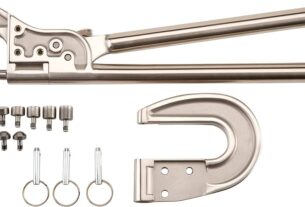If you’re in the manufacturing industry, then you must be familiar with tool holders. A tool holder is a device that holds cutting tools and other accessories properly in place. It is essential for any machining process, as it ensures precision, rigidity, and stability while cutting materials.
The HSK tool holder is one of the most popular types of tool holders used in the industry today. In this article, we’ll discuss everything you need to know about HSK tool holders. From its history and design to its advantages and applications, we’ve got you covered.
History of HSK Tool Holder
HSK stands for “Hohl-Schaft-Konus,” which means hollow-shank-taper in German. The HSK tool holder was developed by the German Machine Tool Builders’ Association (VDW) in the late 1980s. Its main goal was to improve milling performance by providing better accuracy, stiffness, and balance than previous designs.
The first version of the HSK tool holder was introduced in 1989 and was designed specifically for high-speed milling operations. Over time, the design evolved to accommodate various machining processes such as drilling, tapping, and boring.
Design of HSK Tool Holder
The HSK tool holder has a unique design that sets it apart from other types of tool holders. It consists of a hollow shank with a conical shape that tapers towards its end. The shank is held in place by a clamping system that secures the cutting tool or accessory firmly.
One of the significant advantages of the HSK tool holder’s design is its ability to distribute cutting forces evenly across the entire length of the taper. This results in better rigidity and stability during cutting operations, which leads to improved accuracy and surface finish.
Another advantage of the HSK tool holder’s design is its quick-change capability. Unlike other types of tool holders, the HSK tool holder does not require nuts or bolts to secure the cutting tool in place. Instead, it uses a drawbar mechanism that allows for fast and easy tool changes.
HSK Tool Holder Advantages
The HSK tool holder offers several advantages over other types of tool holders. Here are some of its benefits:
1. Improved machining performance: The HSK tool holder’s design provides better accuracy, stability, and rigidity during cutting operations, resulting in improved machining performance.
2. Better surface finish: The even distribution of cutting forces across the entire length of the taper results in better surface finish and reduced chatter marks.
3. Quick-change capability: The HSK tool holder’s drawbar mechanism allows for fast and easy tool changes, reducing downtime and increasing productivity.
4. Compatibility with high-speed spindles: The HSK tool holder is designed to work with high-speed spindles, making it ideal for high-speed machining applications.
5. Reduced maintenance costs: The HSK tool holder’s quick-change capability reduces maintenance costs by eliminating the need for nuts and bolts, which can wear out over time.
Applications of HSK Tool Holder
The HSK tool holder is used in various machining processes such as milling, drilling, tapping, and boring. It is especially useful for high-speed machining applications where accuracy, stability, and rigidity are essential.
Here are some of the industries where the HSK tool holder is widely used:
1. Aerospace industry: The aerospace industry requires high precision and accuracy when machining parts from hard materials such as titanium and Inconel. The HSK tool holder’s design makes it ideal for these applications.
2. Automotive industry: The automotive industry uses the HSK tool holder in various processes such as engine block machining, cylinder head machining, and gearbox manufacturing.
3. Medical industry: The medical industry requires precision when manufacturing medical devices such as implants and prosthetics. The HSK tool holder’s accuracy and stability make it ideal for these applications.
4. Mold and die industry: The mold and die industry requires high precision when machining complex shapes and contours. The HSK tool holder’s design allows for better accuracy and surface finish, making it ideal for these applications.
Conclusion
The HSK tool holder is an essential device in the manufacturing industry, providing improved accuracy, stability, and rigidity during cutting operations. Its unique design allows for quick and easy tool changes, reducing downtime and increasing productivity.
With its compatibility with high-speed spindles, the HSK tool holder is ideal for high-speed machining applications where precision is critical. It is widely used in various industries such as aerospace, automotive, medical, and mold and die.
If you’re looking to improve your machining performance, then consider using the HSK tool holder in your operations. Its advantages will help you achieve better accuracy, surface finish, and productivity.
References:
1. “Design of the Hollow Taper Shank System (HSK) Tool Holder,” JSTOR
2. “Tool Holder Interface Standards,” SME
3. “HSK Tooling Overview,” Sandvik Coromant




